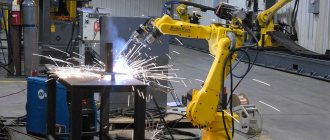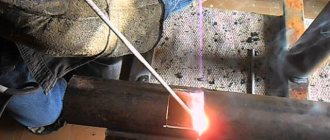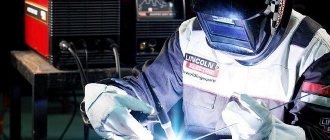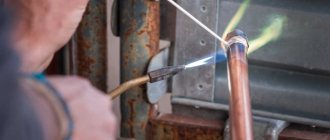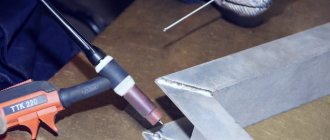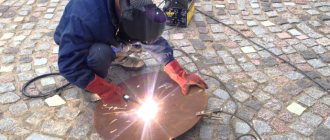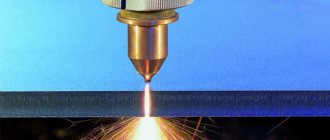Welding is the most reliable and popular method of fastening two metal parts into one. It can be produced in several ways, one of which is gas welding. Let us take a closer look at the advantages and disadvantages of this method, the scope of application of this type of connection and the materials that are needed for soldering using gas welding.
Definition of Gas Welding
Gas welding of metals is a method of joining them that uses gases to create high temperatures. The most commonly used are oxygen and acetylene, although other options are possible. The leading role here is given to the flame, because it is on it that the temperature height and the possibility of melting different types of metals depend. The flame consists of three zones: the core (where acetylene decomposes), the reduction zone (in which carbon and hydrogen are oxidized) and the torch (the area of complete combustion of gases). There are three types of them (depending on the ratio of gases - acetylene and oxygen):
- normal flame, in which gases are supplied in equal proportions. It is characterized by the blue color of all three zones, with the recovery zone having a bright blue color;
- a carburizing flame indicates a lack of oxygen and is characterized by a bright yellow flame;
- oxidizing is the one that occurs when there is a lack of acetylene, in which the flame is pale and short.
To work with gas welding, the master regulates the supply of working gases depending on the flame, the indicator of which is their color. The type of flame determines the temperature that affects the metal. This is usually over 3000 degrees, which allows you to melt and cut various types of products.
Gas welding and cutting of metals is usually carried out using a normal flame, in which acetylene and oxygen are supplied in equal quantities. If the color of the fire changes, you need to adjust the settings.
How to cook with propane
Widespread propane welding is the joining of metal workpieces in a weld pool formed when they are heated by a high-temperature jet of a flammable mixture of two gases. Acetylene and oxygen are usually used as its components, with the latter acting as a catalyst that accelerates the oxidation process and forms a welding jet.
In some cases, propane is chosen as the second component of the oxygen-combustible mixture, from which the name of this method comes.
Principles and features of the process
Welding with propane begins with the fact that the flammable composition enters the torch and comes out under pressure through a special calibrated nozzle. Then the welder ignites the gas, and after it is ignited, he regulates the pressure and quality of the mixture using valves located on the body.
The very thin jet of flame emanating from the nozzle consists of a core, a recovery zone and a working torch. The highest temperature develops in the core; in this case, propane gas welding itself occurs in the gap between it and the reduction zone.
At the same time, due to the effect of high temperatures on the metal being processed, the weld pool is protected from unwanted contact with air.
The possibility of spot processing of metal with a thin jet allows the use of propane welding not only for shaped cutting of initial workpieces, but also in the manufacture of a whole range of decorative products and jewelry.
Scope of gas welding
Gas welding of metals can be carried out in several ways:
- gas flame welding occurs with the help of filler wire, which melts along with the main parts and fills the gap between them;
- Gas press welding is characterized by the absence of filler wire, and bonding occurs through a tight connection of molten edges.
Gas flame welding is not used for all types of metal. It has found its primary application in the following:
- tin and sheet steel, no more than 5 mm thick;
- non-ferrous metals;
- cast iron;
- tool steel.
All these metals have one thing in common - they require soft and smooth heating, which is provided by gas welding.
Gas welding and metal cutting has found wide application in many industrial and domestic sectors. Thanks to the gradual heating of the part, it does not deform and this method is considered one of the best for thin metals. The main thing is to correctly adjust the gas supply and establish the flame. This is done as follows: the oxygen and acetylene valves are fully opened and the burner is ignited (with a match/lighter). The adjustment is made using an acetylene valve with oxygen fully turned off.
The essence of gas welding can be seen in the figure below:
Gases used and their characteristics
Most often, a specific gas, acetylene (C2H2), is used for flame welding. It is characterized by a pungent odor and is produced by the reaction of calcium carbide with water (in an industrial setting). At temperatures above 335 degrees it lights up. In combination with oxygen, the ignition temperature is lower - 297 degrees minimum.
The main gas for gas press welding is oxygen, which is mixed with C2H2 in equal proportions. It is always sold in blue cylinders. Using a hose, oxygen is connected to the burner and supplied at low pressure, no more than 4 atm. C2H2 is connected to the hole nearby. the torch has a special mechanism for mixing gases and the concentrate for the welding process comes out through the tip.
Gas welding and cutting of metals can be carried out not only with acetylene. Instead, it is permissible to use other gases in liquid and vapor form. The most popular acetylene substitutes:
- Kerosene vapors (acetylene replacement ratio – 1:1)
- Propane (acetylene replacement ratio – 1:0.6)
- Methane (acetylene replacement ratio – 1:1.6)
- Hydrogen (acetylene replacement ratio – 1:5.2)
Important: when flame welding steel products with methane or propane, you need to use wire with a high concentration of manganese and silicon.
For high-quality melting of metal, it is recommended that the exposure temperature be twice as high as the melting temperature of this metal.
Great Encyclopedia of Oil and Gas
Gas propane-air and propane-oxygen welding are used more often than other gas welding methods.
It is based on the release of heat during the combustion of flammable gas propane-butane mixed with oxygen. Using gas welding in removable metal forms, aluminum conductors of all sections are connected and terminated. Protection of the metal from oxidation, carried out by a gas flame, ensures high quality connections. Detected welding defects can be easily eliminated if necessary. [5] For gas propane-oxygen welding, accessory sets NSShchS-1, NSPK-2 or NSPU are used. In the absence of these wires, core wires and AF-4a or VAMI flux are used as filler material. [6]
When propane-air and propane-oxygen welding, liquefied fuel gases are used - butane, propane or mixtures thereof. The composition of the mixture is determined depending on the ambient temperature. In the warm season, mixtures with a higher butane content are used, and in the cold season - with a lower one. [7]
The flammable mixture for propane-oxygen welding is formed by propane-butane and oxygen. This makes the welding equipment somewhat cumbersome and immobile. [8]
The PGU-3 installation is designed for propane-oxygen welding of parts up to 4 mm thick and cutting metal up to 12 mm thick when repairing cars - in agricultural vehicles in strong-willed conditions, when performing short-term emergency and plumbing work, as well as in mobile repair shops. Can also be used in training gas welders and carvers. It is a portable case, inside of which there are propane and oxygen cylinders with a capacity of 5 liters, a DKP-1-65 and DGShch-1-65 gearbox, rubber-fabric sleeves, a GZU-3 burner and an RGS-70 insert cutter. When cutting steel, oxygen points require recharging after 15 minutes of work. [9]
LAS-1000 and LAS-1500 tips are used only for electric arc and propane-oxygen welding. [eleven]
The branches can be connected to the busbars by propane-oxygen welding without flux using an NGO type kit, consisting of a two-arm torch with sleeves, a clamping device for fastening welding forms on the wires, a stand for fastening the wires and a set of forms. These sets are manufactured by enterprises of the Ministry of Montazhspetsstroy. When welding branches in mounted spans, brackets are installed on the busbar wires to unload the wires. [12]
Recently, the connection of aluminum cable cores of 800 - 1500 mm2 has also begun to be performed by propane-oxygen welding using a three-arm torch with high heating efficiency. [14]
It is also reliable to terminate aluminum and steel-aluminum wires with a hardware clamp made of aluminum or an aluminum alloy, welded to the wire using propane-oxygen welding. According to the technology proposed by G. G. Kovalev (Volgoelektromontazh), welding of a steel-aluminum wire with a hardware clamp is performed without the operation of biting out steel wires in AC wires. [15]
Advantages and disadvantages
Cooking using the gas method is not difficult, but it, like electric arc, semi-automatic or argon welding, has its advantages and disadvantages.
Advantages of gas connection:
- This is an ideal way to weld copper, brass and cast iron;
- materials with different levels of melting can be processed due to the high temperature generated as a result of combustion;
- you can cook anywhere, since no special equipment or electrical outlet is required;
- when using high-quality additional wire and a correctly selected flame, high-quality and beautiful seams are obtained (widely used for connecting components in pipelines);
- the work product heats up slowly, which avoids deformation or loss, as is the case with semi-automatic welding or when using an electrode).
In addition to the positive aspects, the essence of gas welding also has several disadvantages:
- the heating zone is quite wide, that is, not only the seam zone is heated, but also a large area around it. This may damage the product;
- inability to work with parts whose thickness exceeds 5 mm;
- It is highly not recommended to perform gas-flame overlapping welding, this will lead to deformation of the fusion site;
- high operational hazard, since gases form a chemical mixture that tends to ignite.
Read also: Tool for measuring internal and external threads
Technique and technology of gas welding
In order for gas flame welding to produce a high-quality weld, you must adhere to all recommendations and strictly follow the work technology. First, you need to prepare the edges of the products in the area of the future seam, that is, clean them of various impurities and contaminants. This can be done with sandpaper or a mechanical iron brush. The technology for gas welding and metal cutting is selected in advance, before the start of the process.
Gas welding technology is divided into two methods:
- The right-hand welding method is characterized by the movement of the torch from left to right. In this case, the fiery flame is directed to the welded area, and the additional material is followed after it.
- The left welding method, accordingly, is performed in reverse - from right to left. The wire moves ahead of the flame, which is directed at the not yet connected edges of the parts.
The right-hand welding method is less popular, since the left-hand method is easier to see for the master and provides high-quality heating. Although with the right one, the efficiency is 20% higher and the gas consumption is lower.
Gas welding methods
Particular attention must be paid to the choice of filler wire. It depends on the thickness of the metal that needs to be welded. With the left method, the diameter of the filler wire is d=S/2+1 mm, and with the right method dS/2 mm, where S is the thickness of the product being welded (in millimeters).
The technique and technology of gas welding is selected based on several factors:
- product thickness;
- position of the part and width of the seam;
- master's preferences;
- gases used.
Metal cutting with propane and oxygen - equipment, burner, propane flow and pressure during cutting
Experts, not without reason, believe that gas cutting of metal with propane and oxygen is now the most effective and popular type of cutting.
Let's try to figure out together why this is so. Since this action is performed extremely simply even for a not entirely experienced, but knowledgeable and understanding welder, there is no need for the mandatory use of various bass reflexes. Gas cutting of metal with propane and oxygen, carried out in the active phase, also does not require mandatory compliance with room regulations (in particular, this may include the presence of a central grounding cable).
There is, in addition to this, a completely adequate opinion that the vast majority of gas cutters are, by definition, “mobile”, that is, they can be transported in a completely ordinary way - using road transport.
Gas cutting of metal with propane and oxygen - details of the use of these two industrial gases
Directly during cutting, a gas cutter uses two gases - oxygen, with the help of which, as they say, the processes of metal separation are brought to life, as well as a heater, which can be acetylene or propane.
Using a heater, the surface part planned for cutting is heated up to a temperature value of 1000-1200 degrees, after which an oxygen jet is supplied (so-called metal cutting with oxygen). The jet ignites after touching a heated surface; without contact with it, ignition will be difficult.
Recommendations
When studying the essence of the gas welding process, it is necessary to understand that working with flammable gases requires increased caution and attention. It is recommended for a beginner to take into account the advice of experienced welders and apply them in practice:
- for study and training it is better to use oxygen and acetylene;
- for welding with propane it is better to use a GZU 3-02 torch and Sv08g2s wire;
- before cooking the product, it must be thoroughly cleaned;
- for gas pressure welding, it is better to use hydraulic equipment (press) for reliable bonding;
- The left and right methods have their advantages and disadvantages, so the choice is made by the master, depending on the situation.
We reviewed the basic concepts and materials for flame and gas press welding. For them, a standard mixture of oxygen and acetylene is predominantly used. In some cases, propane welding is used for replacement. This process is not easy and has many nuances that will be difficult for a beginner to take into account. In this regard, novice welders are not recommended to weld with propane. The quality of the seam and the ease of work are affected by preliminary preparation.
Where to order an elevator
There is a widespread, catastrophic problem with elevator equipment in Russia. Every year, tens of thousands of lifts that have expired their warranty period fail. It’s good if the equipment has had time to work
Spare parts for septic tanks
Under such conditions, the best option would be an anaerobic septic tank with soil treatment, since it is simple, energy-independent and rarely maintained. When filtering through soil, wastewater first
Making stamps
Taxi. The first thing that comes to mind with this word is a car, yellow with black checkers, which will take you wherever you want. This word evokes such associations among passengers. How many
Read also: Many sockets in one, what is it called?
Unedged board
Unedged board is a board whose edges are not sawn or partially sawn. It is most often used for the manufacture of various floorings, sheathing, roof sheathing, and elements of load-bearing structures.
Furniture handles online store
Which is cheaper? How not to confuse metabox and tandembox: let's understand the names. Blum and Hettich are the most popular manufacturers of furniture fittings. Often the buyer chooses between them and does not know
Agent's office
How to make the right choice in work, business and life that you will never regret. We want to tell you about an amazing and very simple technique: 7 questions that will allow you to assess the situation
Flags
The national flag is a symbol of the sovereignty of a state entity. Its presence is necessary in all events on a national scale. This flag is often displayed on government buildings.
Wooden table calendar
Today it is difficult to live without up-to-date information, without being oriented in what is happening and without reference to the chronology of events. At the same time, all sensible people know perfectly well that without using a calendar,
Rotational vibrating sieve
Sieves for sifting molding materials must ensure the destruction of lumps and the separation from the total mass of the mixture of pieces of rods, scrap and other random objects that fall into it during knocking out
Gas welding is a work in which, using high temperature, the product is heated and melted to a soft state. This type of welding is often used for structures made of thin carbon steel, for repairing cast iron products, as well as for welding damaged parts made of ferrous or non-ferrous metals.
Features of gas welding
Gases that burn well in air and do not reach high temperatures: acetylene; methane; propane; hydrogen; gasoline vapors.
To burn them, you need an oxygen stream. Welding is most often done using acetylene , which is produced by the reaction of calcium carbide and water. Combustion occurs at temperatures from 3200 to 3400 degrees Celsius.
The valuable qualities of gas welding include the following:
- availability;
- unnecessary availability of electricity;
- simplicity of welding equipment.
However, the process of such work cannot be called highly productive, since everything is done manually. And the operational and mechanical properties of the finished product do not always correspond to high quality.
When the welding machine is operating, oxygen is supplied from a special oxygen cylinder, which, according to GOST, is painted blue or dark blue. To ensure a continuous process, oxygen must be supplied to the burner at low pressure, evenly .
For such purposes, cylinders are equipped with reducers that control and regulate the oxygen supply. Hoses are supplied to the burner - oxygen and acetylene . Oxygen is supplied through the central channel: the jet discharges, sucks in acetylene, which enters the burner under low pressure. In the chamber, the gases are mixed and exit the tip to the outside.
Technology and methods of gas welding
To perform welding and obtain a high-quality connection, you need to pay special attention to the preparation of the seam edges, the connection method, and the choice of torch (its power must match the parameters of the metal being welded).
It is also necessary to thoroughly clean the edges to be welded with a metal brush so that there is no dirt, scale, or slag. Also tack the edges to prevent metal deformation. There are several welding methods.
Left (most used ). Needed for working with low-melting, thin structures. The burner is moved from right to left, the filler wire is passed in front of the flame and directed to the unwelded section of the seam. The right one is characterized by the fact that the torch is inserted from left to right and the filler wire is moved behind the torch.
The heat of the flame is almost not dissipated and the opening angle of the seam is 60-70 degrees. It is considered more advisable to use the right one when connecting metal with a thickness of over 3 mm and with high thermal conductivity. It is recommended to use filler wire with a diameter of half the thickness of the fabric being welded.
Through roller . The sheets are attached vertically to a gap equal to ½ the thickness of the sheet. Using a torch, the edge is melted to create a round hole. It is then melted from all sides until the seam is welded.
Pool welding is suitable for fastening corners and metal joints whose thickness does not exceed 3 mm. The end of the filler wire is inserted into the resulting pool on the seam. It is slightly melted and moved to another section of the seam. This type of welding is suitable for thin sheets and pipes made of steel (low-alloy and low-carbon) and produces a seam of excellent quality.
Multilayer welding : small heating zone; the underlying layers are fired when surfacing the next ones; You can hammer any seam before the next layer.
This will improve the quality of the seam, but there will be low productivity: high gas consumption compared to single-layer welding, and is used only when it is necessary to manufacture high-quality products.
When working with a horizontal seam, use the right method. This helps to form it easily, and the molten metal of the bath does not flow down. The left method is used to weld inclined and vertical seams.
For material thicknesses greater than 5 mm, a double roller is used. Ceiling seams require heating the edges until they melt, then a filler wire is laid into the bath, the end of which quickly melts. The process is carried out in the right way.
Necessary equipment
Devices used for gas welding: acetylene-oxygen; propane-oxygen; gasoline-oxygen; kerosene-oxygen.
The ones most used for welding are propane and oxygen-acetylene machines , since they emit the highest temperatures when burning.
Read also: Soldering strands of copper wires with a torch
More commonly used are acetylene generators, which release acetylene when water and calcium carbide are mixed. This type of generator exists in five types, so it’s easy to choose the right option for a specific metal.
Safety valves play an important role . They provide safety and prevent the backlash of fire that occurs during welding. The valves also block the reverse flow of gas through rubber hoses.
A cylinder is a cylindrical container with a hole and a thread in the neck for screwing in a shut-off valve. Made from carbon or alloy steel. According to GOST, it is painted with a special color of paint, depending on the gas.
Valves for gas cylinders are made of brass (since steel is not resistant to corrosion), always with a left-hand thread, smaller in diameter compared to the valve of an oxygen cylinder (so that there is no possibility of mixing up the gearboxes).
Types of gearboxes
- A gas reducer is a device for controlling gas pressure. For gas welding and cutting you will need different types of gearboxes.
- Oxygen is used in metal welding and gas welding. It has a blue marking on it. Can be used in aggressive environments as it is not afraid of corrosion.
- Acetylene reducers are attached to the cylinder with a snap-on clamp and are marked in white. This type of gearbox comes with two pressure gauges: one monitors the gas pressure in the cylinder, the second monitors the pressure in the working chamber.
- Carbon dioxide reducers are widely used in the chemical and food industries. They are equipped with one or two pressure gauges and are connected to a vertical pressure gauge.
- In argon arc welding, argon gearboxes are used that work with non-flammable gases.
- Gas burners are used in all kinds of industries. All burners are similar in design. Each consists of a housing to which several parts are attached: a valve that controls the gas supply; lever controlling the height of the fire; tip.
Using a reducer, the connection to the cylinder is made. The burner can be equipped with piezo ignition and wind protection .
The burner is safe when working with propane. Maintains a high fire temperature, which is sufficient for a large number of welding jobs. Some types of welding are carried out with acetylene torches using a mixture of oxygen and acetylene.
Gas cutters
The following types of gas cutters are distinguished:
The product consists of a handle, a body, nipples (gas hoses are attached to them), an injector, a tube, a mixing chamber, a gas cutter head, a tube with a valve. Metal welding and its quality depend on how correctly the cutter was selected.
Principle: oxygen is supplied to the reducer, then into the hose and into the housing - the cutter is branched into two channels. One part of the oxygen moves through the valve into the injector. Gas comes out at great speed, while at the same time flammable gas is sucked in.
Combining with oxygen, a flammable mixture is formed , which moves between the mouthpieces and burns. A heating fire appears. Oxygen moving through the second channel passes into the tube, causing a cutting jet to appear. It is she who processes the area of the material.
Do you have any questions about gas welding? (Propane/oxygen).
Hello! I have a few questions about gas welding. Namely: How to unscrew the oxygen cylinder valve? Well, that is, unscrew it all the way (all the way?), or how many turns? How many turns should you turn the propane tank valve? And also, what pressure should be set on the oxygen reducer? And what is the pressure on propane? I tried to search the site for information, but my Internet is very slow, so I created a topic. I count on you!
- View profile
- Private message
There is no welding. Cutting, or at least soldering! And don’t trust anyone, I tried it myself when I was young, nothing comes of it. Acetylene + oxygen - there is welding!
Sanych wrote: How to unscrew the valve of an oxygen cylinder?
After the characteristic “zilch”, no more than 1/4-1/2 turn.
Sanych wrote: how many turns should you unscrew the valve of a propane tank?
this one can be used all the time, but it’s also better not more than a revolution
Sanych wrote: what pressure should be set on the oxygen reducer?
depending on the work performed from 5 to 10 kg, on average it always costs 8
0.2-.03 is enough Good luck!!
- View profile
- Private message
Thanks a lot! You helped me a lot! That is, the order of “turning on” the gas welding (for welding) is as follows: 1) If there is no reducer on propane, then: open the propane cylinder (1 turn), 2) open the oxygen cylinder (half a turn) and set it on the reducer (5 kgf), Then on the burner: 3) open the oxygen valve and vent the burner, then close the oxygen valve (on the burner) 4) open the propane valve and ignite the flame, 5) open the oxygen, adjust the flame with oxygen and you can cook. It's like that?
And for cutting, just set the pressure to oxygen (8 kgf) and unscrew the propane valve on the cylinder more strongly? So?
- View profile
- Private message
Sanych wrote: 1) If propane does not have a reducer, then: open the propane tank (1 turn),
How is this without a gearbox? Reducer needed
Sanych wrote: open the oxygen, adjust the flame with oxygen and you can cook. It's like that?
Before doing this, so that the flame does not break, lean the burner tangentially against the iron. Cooking won't work
Sanych wrote: And for cutting, just set the pressure on oxygen (8 kgf) and unscrew the propane valve on the cylinder more strongly? So?
propane reducer needed! and the pressure on it is always the same!
- View profile
- Private message
Well, there are propane gearboxes with a pressure gauge, and there are flat ones, automatic. I meant that if there is no gearbox with a pressure gauge, and a flat automatic one is installed on the cylinder, then you just need to unscrew the cylinder valve 1 turn. Well, I heard you can cook thin metal with propane. It just takes longer to heat it up. Or is propane welding impossible at all?
- View profile
- Private message
The flat-type gearbox is an RDSG. It is used for household gas stoves in the country, etc. You cannot cook with propane! It's not a matter of temperature, but of chemistry. composition of the flame. The temperature of the propane-oxygen flame is 2700, and the acetylene-oxygen flame is 3100 (the difference is small), with the melting temperature of the metal being 1200-1300. But propane is C3H8! During combustion - C3H8 + 5 O2 = 3CO2 + 4 H2O there is a lot of water and little carbon to restore the weld metal (steel is cooked with a carburizing flame). In the case of acetylene, 2 C2H2 + 5 O2 = 4 CO2 + 2 H2O. See the ratio of carbon dioxide and water? Here's your answer.
- View profile
- Private message
Sanych wrote: Well, I heard you can cook thin metal with propane. It just takes longer to heat it up. Or is propane welding impossible at all?
I came across information in a magazine that you can cook with propane, you just need to remake the burner. I cut out the information and wanted to do this for myself now, if I find that cutting, I’ll throw it off. I’ve had that cutting for many years and I haven’t made such a burner for myself. But it’s been like this for years 15 years ago I saw a set of torches on the market and in the set there was one for welding with propane, and the idea was exactly like in my old magazine clipping. But that set was made at the factory, there was a description of the process and a link to the patent. In short, the patent number was all it was decorated beautifully. But how realistic is it, who the hell knows. In private conversations with welders, at least a couple of people said that they had seen such a burner and it cooked with propane perfectly, but they didn’t have the chance to do it themselves.
- View profile
- Private message
- View profile
- Private message
Pipe welding stages
The metal is prepared, stripped, marked, pipes are cut and assembled. Cutting the round pipe section should be done with a thermal cutter.
Preparation takes most of the work. This includes measurements, markings, cutting and much more. The structure is assembled using gas tack welding , this will prevent displacement and deformation of pipe sections, which can affect the appearance of cracks.
As a result of unhurried heating, the impact zone during gas welding is larger than during arc welding. The layers of the base material directly adjacent to the weld pool are permanent and have a coarse-grained structure.
Very close to the weld boundary there is a zone of incomplete melting of the metal with a large structure typical of an unheated material. In this zone, the strength is lower than that of the weld metal, which is why the destruction of the welding joint occurs here.
Cutting is carried out using metals and alloys that can burn in a stream of pure oxygen. This type of cutting is done in two ways: superficial and dividing . You can cut out blanks, mark metal, and cut the edge of a future seam for welding.
Using surface cutting, surface metal is removed, grooves are filled, and defects are removed. This type of work is performed with special cutters
Health and Safety
When using gas-oxygen processes, all safety requirements are met, which are provided for by the rules for handling gases, working in conditions of elevated temperatures and gas contamination of industrial premises.
To protect against thermal, mechanical and other influences, individual means are used (heat-protective clothing, shoes, sleeves, bibs made of fire-resistant soft material). Respiratory protection is carried out using general-purpose supply and exhaust ventilation, as well as respirators and gas masks. To protect the eyes from the action of radiant energy, as well as sparks and splashes of molten metal, special glasses with light filters or safety glasses with clear lenses are used.
